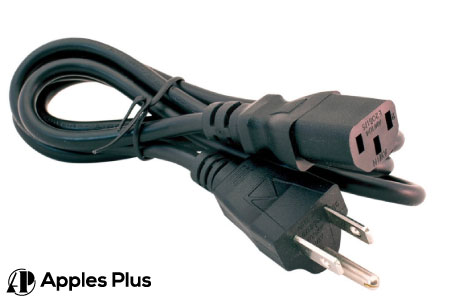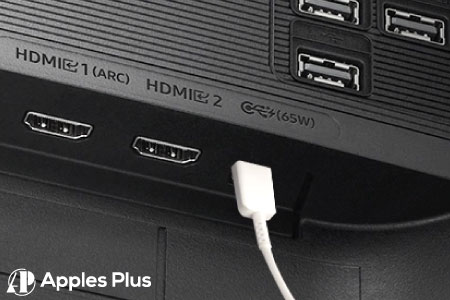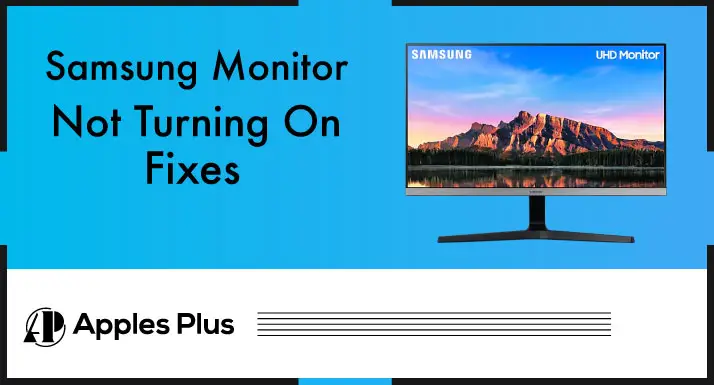Samsung monitors are known for their high-quality displays and reliable performance, but like any electronic device, they can encounter issues from time to time.
Users may encounter one of the most frustrating problems when their Samsung monitor fails to turn on. Several factors, including power source problems, damaged power cables, incorrect computer settings, or faulty monitor hardware, can cause this issue.
In this blog post, we will discuss why a Samsung monitor may not turn on and provide possible solutions to help you troubleshoot the issue and get your monitor up and running again.
Why My Samsung Monitor Not Turning On?
There could be a number of reasons why your Samsung monitor is not turning on. Here are a few things you can try:
1. Check the Power Source:
Checking the power source is one of the first things you should do if your Samsung monitor is not turning on. Here are some steps you can take to check the power source:

- Make sure that the power outlet you are using is working properly. Try plugging in another device to see if it turns on. If the power outlet is not working, try plugging the monitor into a different outlet.
- Ensure the power cord is securely plugged into the monitor and outlet. You should also check the power cord for visible damage, such as cuts, fraying, or kinks. If there is damage, the power cord may need to be replaced.
- If your Samsung monitor comes with an AC adapter, check the adapter to ensure that it is working properly. Look for any visible damage on the adapter and ensure it is securely plugged into the power outlet. If the adapter is damaged, it may need to be replaced.
- If you are using a power surge protector, ensure it works properly. Try plugging the monitor directly into the power outlet to see if it turns on.
If you have checked all these steps and the monitor still won’t turn on, you can move to the next solution tip.
2. Check the Power Cable:
Checking the power cable is a crucial step to take if your Samsung monitor is not turning on. Here are some steps you can follow to limit the power cable:

- Ensure that the power cable is securely plugged into the back of the monitor and the power outlet or surge protector. If the cable is loose, try unplugging and re-plugging it to ensure it is properly connected.
- Inspect the power cable for visible damage, such as cuts, fraying, or kinks. If there is visible damage, the power cable may need to be replaced.
- If you have access to another power cable that is compatible with your Samsung monitor, try using it to see if the monitor turns on. It will help you determine whether the issue is with the power cable or the monitor itself.
- Ensure that the voltage rating of the power cable is compatible with your Samsung monitor. Using a power cable with the wrong voltage rating can damage the monitor or cause it not to turn on.
- If the power cable is not the issue, try plugging the monitor into a different outlet or surge protector to ensure the problem is not with the power source.
If you have followed all these steps and the monitor still won’t turn on, you can move to the next solution step.
3. Check the Connections:
Checking the connections is a crucial step to take if your Samsung monitor is not turning on. Here are some steps you can follow to check the connections:

- Ensure that the power cable is properly connected to the back of the monitor and the electrical outlet. If the cable is loose, try unplugging and re-plugging it to ensure it is properly connected.
- Inspect the power cable for visible damage, such as cuts, fraying, or kinks. If there is visible damage, the power cable may need to be replaced.
- Ensure that the electrical outlet you are using is working properly. Plug in a different device to the same outlet to test it.
- Ensure that the power switch on the monitor is turned on. Some Samsung monitors have a power switch on the back or bottom of the monitor.
- Look for LED lights on the front or bottom of the monitor. If the LED lights are on, it means that the monitor is receiving power.
- If you suspect the outlet is malfunctioning, try plugging the monitor into a different electrical outlet.
If you have followed all these steps and the monitor still won’t turn on, you can move toward our next step.
4. Check the Monitor Settings:
Checking the connections is another important step if your Samsung monitor is not turning on. Here are some steps you can follow to check the connections:
- Ensure that the video cable is properly connected to the back of the monitor and to the computer or other device you are using with the monitor. If the cable is loose, try unplugging and re-plugging it to ensure it is properly connected.
- Inspect the video cable for visible damage, such as cuts, fraying, or kinks. The video cable may need to be replaced if there is visible damage.
- If you have access to another video cable that is compatible with your Samsung monitor, try using it to see if the monitor turns on. It will help you determine whether the issue is with the video cable or the monitor itself.
- Ensure that the monitor is set to the correct input source. Many Samsung monitors have multiple input sources, such as HDMI, VGA, and DVI. Ensure the monitor is set to the input source that corresponds with the video cable you use.
- Ensure that the computer is turned on and that the monitor is properly connected to the computer. Check the display settings on the computer to ensure that the monitor is recognized and configured properly.
If you have followed all these steps and the monitor still won’t turn on, you can move toward our next solution step.
5. Check the Computer Settings:
If your Samsung monitor is not turning on, checking the computer settings is important. Here are some steps you can follow to check the computer settings:
- Ensure the computer is turned on and the display settings are properly configured. On Windows 10, go to “Settings” > “System” > “Display” and make sure that the monitor is recognized and set as the primary display. On Mac, go to “System Preferences” > “Displays” and make sure that the monitor is recognized and configured properly.
- Ensure that the graphics card settings are properly configured. Open the graphics card control panel (such as NVIDIA Control Panel or AMD Radeon Settings) and check the display settings. Make sure that the monitor is recognized and configured properly.
- Ensure that the graphics card drivers are up-to-date. Visit the manufacturer’s website to download and install the latest drivers for your graphics card.
- Ensure that the monitor is compatible with the computer and the graphics card. Check the manufacturer’s website for compatibility information and ensure that the monitor and graphics card support the same resolution and refresh rate.
- If you can access another computer, try connecting the monitor to see if it turns on. It will help you determine if the issue is with the monitor or computer.
If you have followed all of these steps and the monitor still won’t turn on, it may be a more serious issue, and you can move toward our next solution step.
6. Reset the Monitor:
If your Samsung monitor is not turning on, resetting it to its default settings is a possible solution. Here are some steps you can follow to reset the monitor:
- Press the power button on the monitor to turn it off.
- Disconnect the power cable and the video cable from the monitor.
- Press and hold the power button on the monitor for 30 seconds. It will discharge any residual power and reset the monitor.
- Reconnect the power cable and the video cable to the monitor.
- Press the power button on the monitor to turn it on.
- If the monitor turns on, reset it to its default settings by entering the on-screen menu. Press the menu button on the monitor and navigate to the “Reset” option. Select “Reset” to reset the monitor to its default settings.
If you have followed these steps and the monitor still won’t turn on, it may be a more serious issue, and you may need to contact Samsung customer support or take the monitor to a professional repair shop near you.
Why My Samsung Monitor Not Turning On Automatically?
If your Samsung monitor is not turning on automatically, several possible causes could exist. Here are some of the most common reasons and their corresponding solutions:
1. Power Saving Mode:
Your Samsung monitor may be set to a power-saving mode that turns off the monitor after a certain period of inactivity. To fix this issue, you can try moving the mouse or pressing a key on the keyboard to wake the computer from sleep mode.
2. Faulty Power Button:
The power button on your Samsung monitor may be faulty, which prevents the monitor from turning on automatically. In this case, you may need to manually press the power button on the monitor to turn it on.
3. Incorrect BIOS Settings:
Your computer’s BIOS settings may be set to turn off the monitor after a certain period. You can check your computer’s BIOS settings and adjust them accordingly.
4. Driver Issues:
Outdated or incorrect display drivers can cause issues with your Samsung monitor turning on automatically. You can update your display drivers to the latest version to fix this problem.
5. Hardware Issues:
If none of the above solutions work, your Samsung monitor may have a hardware issue. In this case, you should contact Samsung customer support or take the monitor to a professional repair shop to fix it.
By troubleshooting these potential causes, you can identify why your Samsung monitor is not turning on automatically and take the necessary steps to fix the issue.
Why My Samsung Monitor No Power Light?
If your Samsung monitor is not displaying a power light, it may indicate that the monitor is not receiving any power or is not turning on. Here are some of the most common reasons why your Samsung monitor may not have a power light:
- If the power outlet is not working or the power cord is not properly connected to the monitor, the monitor may not receive any power. Check the power outlet and power cord to ensure that they are functioning properly and are properly connected.
- If the power cable is damaged or faulty, it may prevent the monitor from receiving any power. Inspect the power cable for any visible damage or wear and replace it if necessary.
- If the monitor’s power supply is defective, it may prevent the monitor from turning on. In this case, you may need to contact Samsung customer support or take the monitor to a professional repair shop to fix it.
- If the monitor is defective or damaged, it may not turn on or display a power light. In this case, you may need to contact Samsung customer support or take the monitor to a professional repair shop to fix it.
By troubleshooting these potential causes, you can identify why your Samsung monitor is not displaying a power light and take the necessary steps to fix the issue.
Why is My Samsung Monitor Blinking?
If your Samsung monitor blinks, it could be caused by several reasons. Here are some of the most common reasons and their corresponding solutions:
- If the video cable connecting the monitor to the computer is not securely plugged in, it may cause the monitor to blink. Ensure the video cable is properly connected and tighten any loose connections.
- A damaged or faulty video cable can cause your Samsung monitor to blink. Inspect the video cable for any visible damage or wear and replace it if necessary.
- Outdated or incorrect display drivers can cause your Samsung monitor to blink. Check to make sure that your display drivers are up to date.
- Occasionally, incorrect resolution and refresh rate settings on your computer can cause the monitor to blink. Check your computer’s display settings and ensure they match your Samsung monitor’s recommended settings.
- Your Samsung monitor may be set to a power-saving mode that causes it to blink. To fix this issue, move the mouse or press a key on the keyboard to wake the computer from sleep mode.
- If none of the above solutions work, your Samsung monitor may have a hardware issue. In this case, you should contact Samsung customer support or take the monitor to a professional repair shop to fix it.
By troubleshooting these potential causes, you can identify why your Samsung monitor is blinking and take the necessary steps to fix the issue.
How to Turn On Samsung Monitor without Buttons?
Turning on a Samsung monitor without using the power button is impossible. The power button is an essential component that initiates the power-up process. However, some workarounds can help you turn on the monitor without pressing the power button. Here are a few options:
- Some Samsung monitors have a built-in feature that allows you to turn on the monitor by pressing a specific key combination on the keyboard. The key combination varies depending on the model of the monitor. Refer to the user manual or check Samsung’s website for your monitor’s key variety.
- Some Samsung monitors come with a remote control that can be used to turn on the monitor. If your monitor comes with a remote control, refer to the user manual for instructions on how to use it to turn it on the monitor.
- The MagicBright feature on Samsung monitors automatically adjusts the brightness, contrast, and other display settings based on the displayed content. Some Samsung monitors have an “Auto” setting for MagicBright that turns on the monitor automatically when it detects a video signal.
- You can use a smart plug to turn on the power to your Samsung monitor remotely using a mobile app or voice command. However, this option requires a smart plug to be installed and connected to your Samsung monitor.
While these options can help you turn on your Samsung monitor without pressing the power button, they may not work for all models or situations. It is always recommended to use the power button on the monitor whenever possible to avoid any potential issues or damage to the device.
Why My Samsung Monitor Touch Buttons Not Working?
If the touch buttons on your Samsung monitor are not working, there could be several potential reasons for this. Here are a few possible solutions you can try to troubleshoot the issue:
- Dirt or dust buildup on the touch buttons can interfere with their functionality. Use a clean and dry microfiber cloth to gently clean the touch buttons and remove any debris obstructing them.
- Try resetting the monitor to its default settings by turning it off and unplugging it from the power source for a few minutes. Then, plug it back in and turn it on to see if the touch buttons work.
- Ensure the monitor is properly connected to the computer and securely plugged into the video cable. A loose connection can sometimes cause the touch buttons to malfunction.
- Some Samsung monitors have a locking feature that disables the touch buttons. Check your monitor’s user manual for instructions on how to disable this feature.
- Outdated firmware can sometimes cause issues with the touch buttons on Samsung monitors. Check the Samsung website for any available firmware updates for your monitor, and follow the instructions to install them.
- If none of the above solutions work, the touch buttons on your Samsung monitor may be defective or malfunctioning—Contact Samsung support for further assistance and potential repair or replacement options.
By trying these solutions, you can resolve the issue with your Samsung monitor’s touch buttons not working.
Conclusion
In conclusion, a Samsung monitor not turning on can be a frustrating issue, but there are several potential solutions that you can try to troubleshoot the problem.
From checking the power source and cables to resetting the monitor and updating the firmware, there are many steps you can take to diagnose and fix the issue. If none of these solutions work, it may be necessary to contact Samsung support for further assistance.
By taking these steps, you can get your Samsung monitor up and running again and enjoy your display as intended.

Meet Harry, the author of Apples Plus! Harry is a highly skilled electronic engineer passionate about testing and reviewing tech products like monitors and soundbars. With years of experience in the industry, Harry has developed a keen eye for detail and an in-depth understanding of the latest tech trends and developments.


